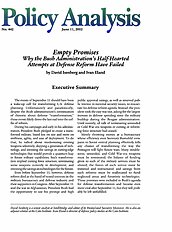During his campaign and early in his administration, President Bush pledged to create a transformed military, based less on size and more on swiftness, agility, and ease of deployment. To do that, he talked about modernizing existing weapons selectively, skipping a generation of technology, and investing the savings in cutting-edge technologies that would provide a quantum leap in future military capabilities. Such transformation implied cutting force structure, terminating some weapons currently in development, and investing the savings in technologies for the future.
Even before September 11, however, defense reform died at the hand of vested interests in the military bureaucracy and defense industry and their supporters in Congress. After September 11 and the war in Afghanistan, President Bush had the opportunity to use his prestige and high public approval ratings, as well as renewed public interest in national security issues, to resuscitate his defense reform agenda. Instead, the president took the easy way out, asking for the largest increase in defense spending since the military buildup during the Reagan administration. Until recently, all talk of terminating unneeded or Cold War-era weapons or cutting or reforming force structure had ceased.
Merely throwing money at a bureaucracy whose efficiency even Secretary Rumsfeld compares to Soviet central planning effectively kills any chance of transforming the way the Pentagon will fight future wars. Many troublesome, unneeded, and Cold War-era weapons must be terminated; the balance of funding given to each of the military services must be altered; the forces of each service must be trimmed and restructured; and savings from such reforms must be reallocated to fund neglected areas and futuristic technologies. Those promises were included in Bush’s agenda for defense transformation and became even more vital after September 11, but they will probably be left unfulfilled.



